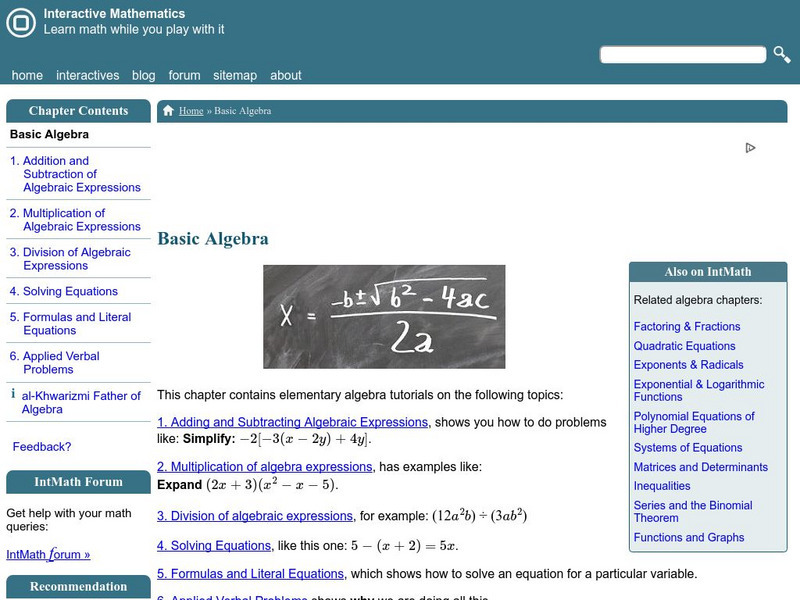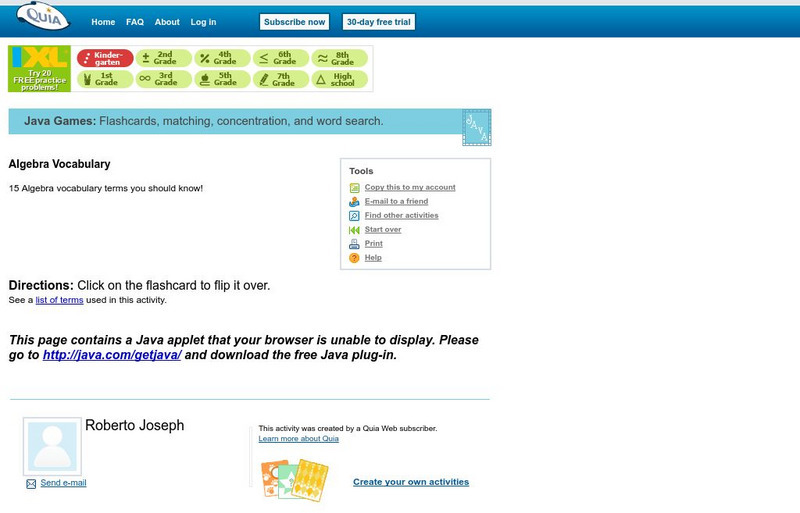Curated OER
Fibonacci II
Study Fibonacci sequences and see a related set of numbers. Learn and review Lucas numbers and use of quadratic equations to find a general term of a sequence of numbers that is generated by a recurrence relation similar to Fibonacci's.
Pyro Innovations
Get into Shape
Shapes are so fun! Little ones explore, identify, and create shapes using tangrams or pattern blocks. The activity is intended to stimulate critical thinking while engaging learners through play and shape identification. Each child will...
Curated OER
My Foot and the Standard Foot
Young mathematicians put one foot in front of the other as they learn how to measure length in an elementary math lesson. Using paper cutouts of their own feet, children measure classroom objects as they discover the importance of...
Virginia Department of Education
Rational Functions: Intercepts, Asymptotes, and Discontinuity
Discover different patterns by making connections between a rational function and its graph. An engaging lesson plan asks scholars to explore the behavior of different rational functions. Groups discover a connection between the...
University of Wyoming
Free Fall…From SPACE!/Nanotechnology in the Classroom
Provide the details about Felix Baumgartner's sky jump from the far reaches of our atmosphere, 39,045 meters up! Then get your physics free fallers to evaluate the factors that played a role in his acceleration, the time to reach maximum...
Curated OER
Telling Time to 5 Minutes
In this second grade lesson your class will practice telling time. The goal is to tell time to five minutes using an analog clock. Your young students count by 5 minute intervals and discuss elapsed time.
Curated OER
Characteristics of Exponential Functions
What can an upper grader do with an exponential function? They can solve and graph it, identify its important characteristic, and differentiate graphs based on shifts in graph bases that are greater or less than one. This 45 minute...
Alabama Learning Exchange
Pattern and Practice
Young scholars learn how to make patterns. Students first display their prior knowledge of patterns before delving into the lesson. They complete a worksheet and participate in a web-based class activity. They work in cooperative groups...
Curated OER
Dinosaur Tracks: From Stride To Leg Length To Speed
Students determine the relationship between leg length, stride length, and speed in humans and bipedal dinosaurs. They collect data and graph these human characteristics then use actual data collected from dinosaur track pads and fossils...
Curated OER
Parallel and Perpendicular Lines
Tenth graders explore parallel and perpendicular lines. In this geometry lesson, 10th graders investigate the relationships associated with parallel lines and transversals, perpendicular lines, and the angles formed by these...
Curated OER
I Spy a Pattern-Kindergarten
Students copy, create, describe, and extend patterns with objects. They explore a variety of patterns through the use of manipulatives, sound, rhythms, songs and movement. Cooperative processes are used to encourage partner discussion.
Curated OER
Making Movies
Students use interactive white boards to solve math problems. In this math problems lesson plan, students produce math casts where they can solve problems, write out descriptions, and communicate what they know and do not know on the...
Curated OER
What Are The Chances
Learners calculate the probability of an event occurring. For this probability lesson, students differentiate between independent, dependent or compound events. They find the range of the data.
Curated OER
Shape Detectives
Students become "shape detectives" as they identify, name, create and describe common shapes within pictures and objects found within the learning environment. Suggestions include incorporating shapes into all learning areas and daily...
Curated OER
Addition Properties
Student study addition properties. For this addition properties lesson, young scholars use multiple methods to solve various types of problems. Students illustrate and describe in various ways the Commutative Property of Addition....
Curated OER
Studying Living Organisms
Students discover and discuss the differences between prokaryotes and eukaryotes. Using a microscope, they examine various prepared slides of prokaryotic and eukaryotic organisms.
Curated OER
Pythagorean Theorem Investigation
Eighth graders investigate the Pythagorean Theorem and practice applying the theorem to various triangles. Finally, in the next lesson in the sequence, 8th graders create a song or a story to help them remember the Pythagorean Theorem.
Curated OER
Prime and Composite Numbers with use of manipulatives (Elementary, Mathematics)
Students learn what prime and composite numbers are. They learn how to identify them by working in a group and demonstrating an understanding of one work problem with 100% accuracy using the manipulatives provided.
Curated OER
Pythagorean Theorem
Students solve right triangles using the Pythagorean Theorem. In this solving right triangles using the Pythagorean Theorem lesson plan, students find the missing side of a right triangle. Students find the hypotenuse given...
Curated OER
Studying Fossils: Dinosaur Tracks From Stride to leg Length to Speed
Students explore dinosaurs. Students determine the relationship between leg length, stride length, and speed in humans and bipedal dinosaurs. Students analyze collected information. Based upon the data, dinosaur tracks, and fossils,...
Curated OER
Global Symposium
Ninth graders work together to develop a sysnopis on the Earth. Using the Internet and print sources, they focus on one country to research and determine its condition. They offer possible solutions to the problem and share their...
Interactive Mathematics
Interactive Mathematics: Basic Algebra
Interactive lessons are provided for many topics in algebra, including: laws of algebra, powers, roots and radicals, algebraic expressions, equations, and more. Use the links to navigate the tutorial and learn more focused concepts. The...
Quia
Quia: Algebra Terms
Do you need practice learning and remembering algebra vocabulary terms? This practice with flash cards is the web site for you! There is a link to a list of terms with definitions you can click if you want to see if you are correct.
Quia
Quia: Algebra Terms
Do you need practice learning and remembering algebra vocabulary terms? This word search game is the web site for you! There is a link to a list of terms with definitions you can click if you want to see if you are correct.























